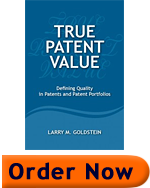1.”In True Patent Value, Larry M Goldstein provides an excellent overview of ‘good patents’ and ‘seminal patents’, and the critical importance of claim ‘validity’ and ‘claim scope’.”
– “Patent quality: implementation insights for the C-suite”, by Dr. Bruce Rubinger, Fonder and Managing Director of Global Prior Art, Inc., published in the 2016 Yearbook of Intellectual Asset Management (IAM) Magazine.
2. TRUE PATENT VALUE “grapples with the question, ‘Is a patent any good?’ This is something that all LES members ask, and this book begins to shed light on the quality issue of patents. It is a very good reference book…”
Dwight C. Olson and David Drews, in a review published in the March, 2014, edition of Global News of LESI (Licensing Executives Society International), one of the leading organizations in the world for licensing patent and intellectual property rights.
3. “TRUE PATENT VALUE is Larry M. Goldstein’s manifesto, his credo, his unique message, his rallying cry to the value-sensitive sector of the intellectual property world….Whether you fancy a go at valuing your own patents or…want to get a genuine feel of the subject so that you can better assess the advice received from professionals, you won’t be disappointed by this readable, lucid tome.”
http://ipkitten.blogspot.co.il/2013/12/a-little-december-reading.html#!. Jeremy Phillips, in the blog entitled IPKat, December 1 2013.
4. “TRUE PATENT VALUE is an extremely useful resource for patent attorneys and agents of all levels of experience, and for anyone else who wishes to understand what makes a patent good and valuable. With detailed explanations and examples based on real patents, cases, and transactions, the book explains concepts of patent value in a way that is easy to understand and with lessons that can be put into practice. Excellent and well done!”
Gary A. Hecht Patent Litigator and Partner, Fox Rothchild LLP (Philadelphia)
5. “TRUE PATENT VALUE provides a systematic and objective framework for assessing patent quality and value. The method of analysis will be extremely useful to entrepreneurs, engineers, business managers, corporate executives, and analysts of high-tech companies. Logically structured and well presented, the book explains major ideas in a clear and user-friendly way.”
Brian N. Kearsey Founder of the W-CDMA patent pool (London)
6. “TRUE PATENT VALUE is a masterpiece and a true best practice for any business man, accountant, attorney or dreamer that wants to know what his Patent is worth.”
http://www.amazon.com/True-Patent-Value-Defining-Portfolios/dp/0989554104. O. Falk, August 11, 2013, from an Amazon.com review.
7. TRUE PATENT VALUE “is a welcome change from the (‘excessive’, in this reviewer’s opinion) attention being paid to the financial value of patents as a new form of asset class. Before there can be a dollars and cents valuation, the patent in question must meet the test of being either objectively “good” or “bad”. Once this is ascertained, all of the parties active in the patent marketplace will be a better position to better assess the financial value of the patent at issue. Goldstein’s book is an easily readable and a well-thought-out explanation of how the process of determining “good” and “bad” patents should take place.”
http://ipfinance.blogspot.co.il/2013/09/book-review-true-patent-value.html. Neil Wilkof, in the blog entitled IPFinance, September 2, 2013.
8. “For those with a deep interest in patent evaluation and value assessment, TRUE PATENT VALUE is a thoughtful and thought-provoking resource. After outlining core concepts in patents and their valuation, the book dedicates 300 pages to case studies and anecdotes associated with more than two dozen patents from court cases, ITC actions, patent pools, patent sales and PTO citation records. The author explains what makes these particular patents stand out, provides background and helpful charts to guide the reader to an understanding of the claim language in the patents at issue, and explains how related court cases developed and were decided. Valuable ‘lessons learned’ conclude each case study.
To understand the workings of patents and their value, there is no substitute for delving deep into court cases and the nuance of particular patents. Larry Goldstein speeds the reader through that process, sharing his insights into what makes for a “good patent” and the types of mistakes that should be avoided.”
http://www.amazon.com/True-
9. “[A] very useful book not just for patent attorneys but for all those who wish to understand both what makes a ‘good patent’ and what creates ‘true value’ in a patent…There is a dearth of books that explain these terms about patents clearly in an understandable manner from a pragmatic perspective…[T]here are many books and articles about patents and how to value a patent in strictly financial and numerical terms but surprisingly none that actually define what is patent quality and how this is connected to the value of a patent…True Patent Value does appeal to both camps [engineers, entrepreneurs and inventors on the one hand, and also patent attorneys and agents on the other hand] because in the preface Goldstein outlines which chapters are appropriate reading for the above mentioned categories… Overall this book is very well structured and consistently deals with the link between quality patents and good patents and how this equation is realised as value. It provides valuable insight into the workings of the US patent system and how patent value is assessed.”
Ruth Taplin, Professor of Economics at The University of Leicester, Interdisciplinary Journal of Economics and Buisness Law, December, 2013.
